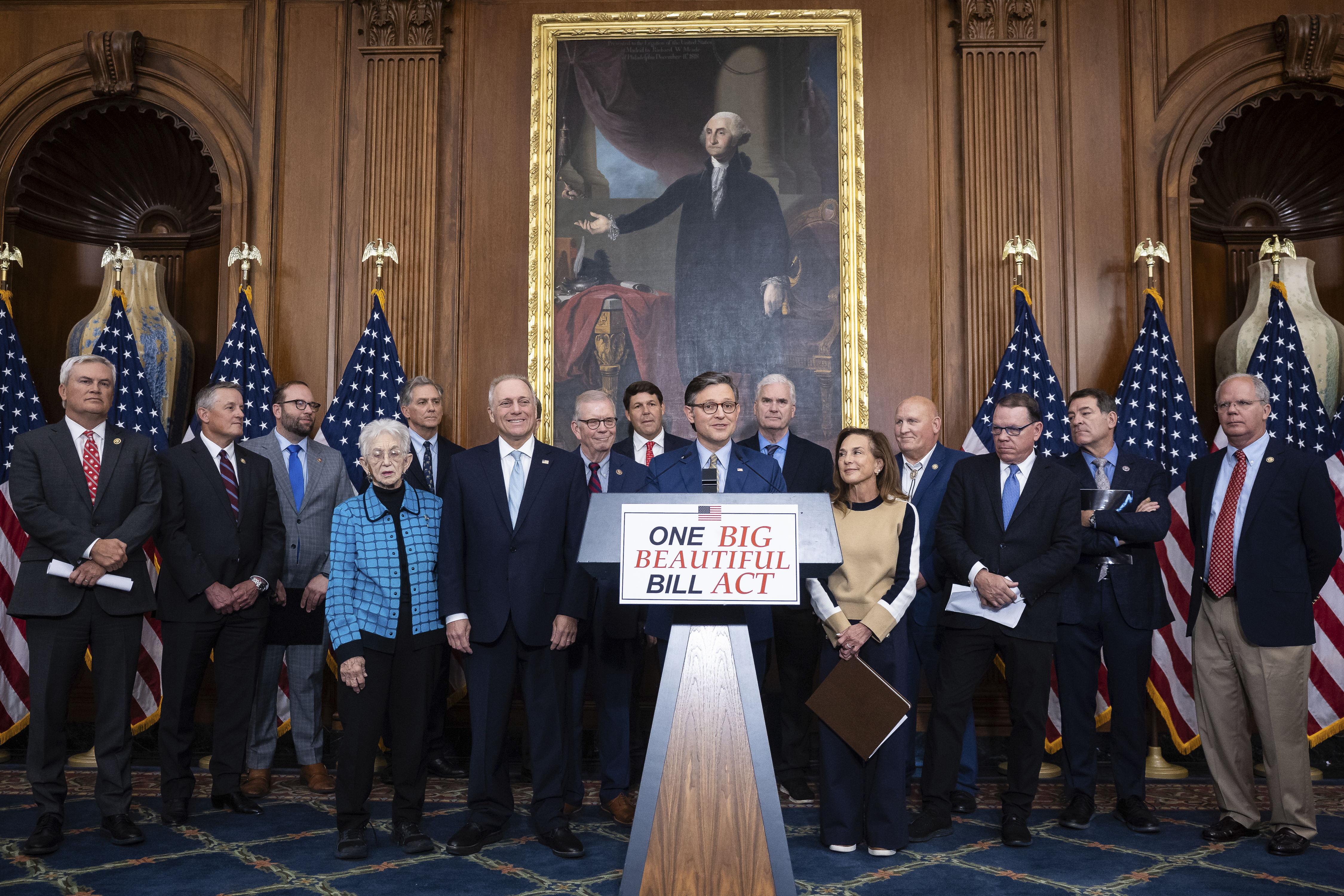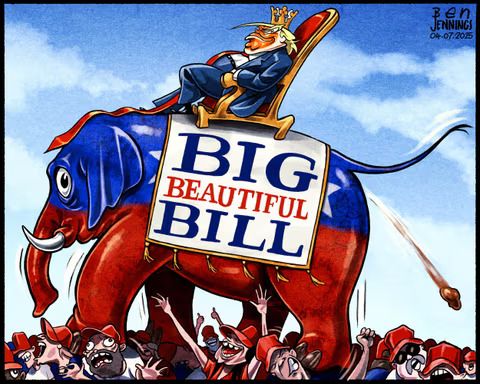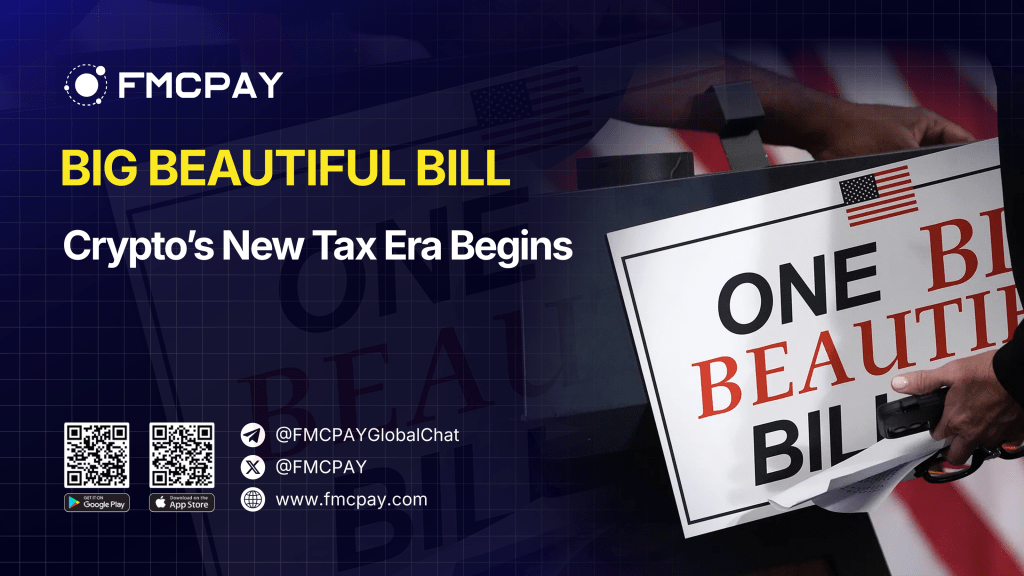In a historic move that could reshape the crypto landscape, the U.S. Congress has passed the sweeping “One Big Beautiful Bill” a controversial yet impactful legislative package that blends massive tax cuts, increased deficit spending, and long-awaited regulatory updates for digital assets.
While the bill has stirred intense political debate, its implications for the crypto industry are immediate and far-reaching offering both clarity and complexity in equal measure. As markets react and policymakers sharpen their focus on Web3, this moment marks a critical turning point for how crypto is taxed, traded, and integrated into the broader economy.
1. What Is the Big Beautiful Bill?
As Washington ramps up efforts to redefine America’s economic future, the passage of the One Big Beautiful Bill Act or simply, the Big Beautiful Bill marks a seismic shift not just in fiscal policy but in how innovation, investment, and digital assets are treated under federal law. Enacted on July 4, 2025, this bill emerged as the centerpiece of President Trump’s second-term agenda, promising tax relief, regulatory rollbacks, and a push for American economic “independence” including in the fast-moving world of crypto.

1.1. A Landmark Bill in a Shifting Political Landscape
The bill didn’t just appear overnight. It was the result of months of heated negotiations between Republicans pushing for deeper tax cuts and a libertarian-leaning bloc demanding clearer frameworks for emerging financial technologies. Crypto gained attention not through lobbying alone but because its mainstream adoption and volatility had become impossible to ignore.
Here’s what’s politically and economically significant about the Big Beautiful Bill:
-
It passed the Senate by a razor-thin 51–50 vote, with Vice President J.D. Vance casting the tie-breaking ballot highlighting just how divided Congress is on the nation’s financial future.
-
Proponents pitched it as a “pro-growth, anti-bureaucracy” overhaul. Opponents labeled it a “Trojan horse for deregulation and deficit spending.”
-
While the bill broadly focuses on tax reform and federal spending cuts, its crypto sections were added late in the process, thanks in part to pressure from Senators Cynthia Lummis and Bill Hagerty both long-time supporters of digital asset innovation.
This isn’t just fiscal reform it’s Washington planting a flag in the digital economy.
1.2. Crypto Enters the Legal Mainstream For Better or Worse
For years, crypto operated in a legal gray area treated as property, taxed like stock, and enforced like cash. With the Big Beautiful Bill, that ambiguity is starting to fade. Here’s how:
-
Staking and Mining Finally Recognized: Instead of taxing block rewards as income on receipt an accounting nightmare for many users the bill defers taxation until the rewards are sold. This change wasn’t just a tax shift, but a signal that crypto is being recognized as a long-term economic activity, not a short-term gimmick.
-
No More Free Rides on Tax-Loss Harvesting: Traders who relied on wash-sale loopholes now face stricter guardrails. That means fewer options for reducing taxable income through fast trades an especially hard hit to automated trading strategies and crypto hedge funds.
-
Everyday Use Still Burdened by Complexity: The crypto community had hoped for a “de minimis exemption” that would encourage adoption in real-world payments. Its absence sends a message: crypto is still viewed as an investment asset not as money. This maintains a fundamental disconnect between how users treat crypto and how the IRS treats it.
-
Regulatory Signal to Other Agencies: While not directly about DeFi, NFTs, or DAOs, the bill is a green light for regulators like the SEC and CFTC to start developing more formal oversight mechanisms, particularly now that Congress has acknowledged crypto in national law.
2. Highlights of the Big Beautiful Bill
With nearly 1,000 pages of sweeping reforms, the Big Beautiful Bill touches everything from personal taxes to digital assets. For crypto users, it introduces some of the most significant policy changes to date offering both new clarity and fresh complications.

2.1. Wash Sale Rule Now Applies to Crypto
A major change that will reshape trading strategies across the crypto market: the bill officially extends the wash sale rule to digital assets. Under this rule, if an investor sells a crypto asset at a loss and then repurchases the same or a “substantially identical” asset within 30 days, that loss can no longer be claimed as a tax deduction.
Previously, this was a commonly exploited loophole. Crypto traders especially high-frequency bots and tax-savvy investors would sell tokens like ETH, BTC, or SOL at a strategic loss near year-end, then quickly rebuy them to maintain market exposure while still booking a write-off. With the new rule, this tactic is now disallowed forcing traders to rethink portfolio rebalancing and capital gains planning.
2.2. Tax Deferral for Staking and Mining Rewards
In a win for the proof-of-stake and mining communities, the bill introduces a long-requested fix: crypto rewards will now only be taxed when sold, not when earned.
Until now, miners and stakers faced significant tax challenges. For example, an Ethereum validator earning block rewards had to report the fair market value of tokens at the time of receipt as income even if they hadn’t sold or realized any actual cash. This was particularly problematic during market downturns, where token values could crash before sale, yet tax liability remained locked in.
With this change, miners and stakers gain the same tax deferral treatment as equity investors, better aligning crypto tax law with real economic behavior.
2.3. No Relief for Small Crypto Transactions
Despite broad support from the crypto community and some bipartisan lawmakers, the bill did not include the proposed de minimis exemption. This exemption would have allowed tax-free use of crypto for transactions under $200 making it easier for consumers to use Bitcoin, USDC, or other tokens for day-to-day purchases.
Its exclusion means that every crypto transaction is still a taxable event no matter how small. Whether you’re tipping a creator online, buying a cup of coffee, or donating to a nonprofit in ETH, you’ll need to track and report cost basis, market value, and gains or losses.
2.4. Major Tax Cuts and Major Trade-Offs
The broader focus of the Big Beautiful Bill is on reshaping the American tax system. Among the changes:
- Permanent cuts to individual income taxes, including exemptions on overtime and tip income
- Reductions to payroll taxes and Social Security contributions
- Incentives for certain types of labor, like service work and gig economy participation
While these changes are popular among workers and businesses, they come with steep costs. The bill is projected to add between $2.4 and $2.8 trillion to the national deficit by 2034. To partially offset this, the bill imposes deep cuts to federal spending, including:
- Medicaid and SNAP reductions, affecting low-income families
- Energy and sustainability programs, including EV credits and clean-tech subsidies
- Public health and education budgets, sparking concern from state governments and advocacy groups
3. What Does the Big Beautiful Bill Do for Crypto?
The Big Beautiful Bill marks the most significant piece of crypto-related legislation ever passed in the United States. While not exclusively focused on digital assets, its crypto provisions represent a tectonic shift in how the federal government classifies, taxes, and interacts with the blockchain economy.

3.1. The Big Beautiful Bill Recognizes Mining and Staking as Investment Activity
One of the most groundbreaking elements of the Big Beautiful Bill is its formal recognition of crypto mining and staking rewards as investment income with taxation deferred until the assets are actually sold.
Why this matters:
-
Under prior IRS guidance, staking and mining rewards were taxed as income when received, even before users had the chance to realize any gains. This created unfair burdens during volatile market cycles.
-
The Big Beautiful Bill eliminates this mismatch, aligning tax treatment with real economic behavior and providing relief for validators, miners, and infrastructure participants.
-
It positions long-term engagement in blockchain networks as a legitimate and viable investment strategy.
By recognizing staking and mining as value-generating activities rather than speculative income, the Big Beautiful Bill encourages broader participation in decentralized ecosystems.
3.2. The Big Beautiful Bill Tightens Tax Rules for Active Traders
The Big Beautiful Bill extends the wash sale rule to include digital assets — a major shift that brings crypto trading into closer alignment with securities markets.
What this changes:
-
Investors can no longer sell a crypto asset at a loss and repurchase it (or a similar asset) within 30 days to claim a tax deduction.
-
This closes a widely used tax loophole and forces traders particularly those using bots or high-frequency strategies to rethink their approach.
-
By applying securities-style tax enforcement, the Big Beautiful Bill signals that digital assets are entering the regulatory mainstream.
While this move may increase short-term tax burdens for traders, it also strengthens the perception of crypto as a mature and regulated asset class a step toward long-term legitimacy.
3.3. The Big Beautiful Bill Leaves Everyday Crypto Use Taxable and Complicated
Despite industry efforts, the Big Beautiful Bill does not include a de minimis exemption for small crypto transactions a change that would have allowed everyday purchases (e.g., under $200) to occur without triggering taxable events.
Why this matters:
-
Every crypto transaction, no matter how small, remains a taxable event under the current IRS framework.
-
The Big Beautiful Bill preserves this status quo, continuing to treat crypto as property rather than currency.
-
This decision discourages real-world crypto payments, making adoption harder for consumers, merchants, and payment platforms.
Without this exemption, the Big Beautiful Bill falls short of unlocking crypto’s everyday utility, reinforcing its role as an investment vehicle rather than a medium of exchange.
3.4. The Big Beautiful Bill Signals a New Era of Regulation
Beyond taxes, the Big Beautiful Bill sends a strong signal to regulatory agencies like the SEC, CFTC, and IRS: it’s time to build a modern, coordinated framework for digital assets.
What’s likely to follow:
-
Enhanced oversight of decentralized finance (DeFi), stablecoins, DAOs, and NFTs.
-
Clearer guidelines around token classification, custody rules, and investor protections.
-
More structured enforcement mechanisms across both centralized and decentralized ecosystems.
By codifying crypto in federal law, the Big Beautiful Bill legitimizes the asset class and opens the door for further rulemaking and legislation that could shape Web3 for years to come.
4. Big Beautiful Bill Update: Market Response
The passage of the Big Beautiful Bill sent a clear signal to financial markets and crypto responded swiftly.
Immediate Market Rally
-
Bitcoin (BTC) surged past $109,000, gaining over 3% within hours of the bill’s passage.
-
Ethereum (ETH), Solana (SOL), and other leading altcoins followed suit, rising between 4–6%, as investor sentiment turned bullish across the board.
-
Crypto-related equities such as Coinbase (COIN) and Riot Platforms (RIOT) also posted strong intraday gains.
Why the Rally?
Analysts point to two key drivers behind the market’s reaction:
-
Regulatory Clarity
The bill introduces long-awaited tax and legal definitions for digital assets, giving investors especially institutions greater confidence to allocate capital. By reducing legal ambiguity around staking, mining, and trading, the Big Beautiful Bill helps frame crypto as a more stable, predictable asset class. -
Inflationary Stimulus Expectations
With the bill’s sweeping tax cuts and increased deficit spending projected to inject trillions into the economy, investors anticipate a weaker dollar and rising inflation historically bullish conditions for Bitcoin and other decentralized stores of value.
5. Risks and Criticism: A Divisive Trade-Off
While the Big Beautiful Bill delivers substantial tax relief and long-overdue regulatory clarity for the crypto sector, it has also sparked intense backlash across the political and economic spectrum.
It will massively increase the already gigantic budget deficit to $2.5 trillion (!!!) and burden America citizens with crushingly unsustainable debt https://t.co/dHCj3pprJO
— Elon Musk (@elonmusk) June 3, 2025
“Political Suicide,” Say Critics
-
Elon Musk didn’t hold back, labeling the bill “political suicide” and “economically insane” in a widely shared post on X .
-
Opponents argue the legislation is heavily skewed toward the wealthy, offering generous tax breaks to high-income earners and investors, while slashing funding for critical social programs like Medicaid, SNAP, and clean energy subsidies.
Relief for Investors, Cuts for Communities
-
Analysts warn that while the bill may boost markets in the short term, its long-term fiscal impact could be destabilizing, with projections suggesting it may add $2.4 to $2.8 trillion to the national deficit over the next decade.
-
The bill’s deficit-driven approach to tax reform has raised concerns among economists who fear inflation, higher interest rates, and weakened public infrastructure.
Crypto Usability Still Undermined
-
Perhaps most disappointing for the crypto community is the failure to include a de minimis exemption for small transactions.
-
Without it, every crypto payment no matter how minor remains a taxable event, stalling hopes for mainstream adoption in retail, tipping, and micro-commerce.
-
Critics argue this omission reinforces crypto’s status as a speculative asset, rather than enabling its potential as a usable, peer-to-peer form of digital cash.
Final Take
The Big Beautiful Bill isn’t just another piece of tax legislation it’s a watershed moment in the evolving relationship between cryptocurrency and U.S. federal policy.
For the first time, activities like staking, mining, and digital asset trading are being formally recognized and classified under U.S. tax law. This long-awaited clarity removes years of legal uncertainty and signals that crypto is no longer operating in a regulatory gray zone it’s now firmly on the books.
While the bill stops short of making crypto easier to use for everyday payments, it marks a decisive step toward mainstream integration. The U.S. government is no longer treating crypto as a fringe innovation; it’s treating it as a permanent part of the financial system.
As the dust settles, one thing is clear: this is the beginning of a new era for digital assets one defined by compliance, legitimacy, and institutional momentum.
At FMCPAY News, we’re tracking the next steps from IRS enforcement updates to potential de minimis reform and evolving SEC/CFTC oversight. Subscribe now to get real-time updates, expert insights, and deep dives into how legislation like the Big Beautiful Bill will shape your portfolio, your business, and the future of Web3.

